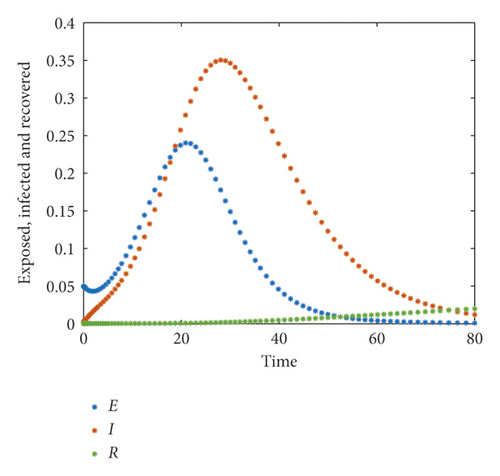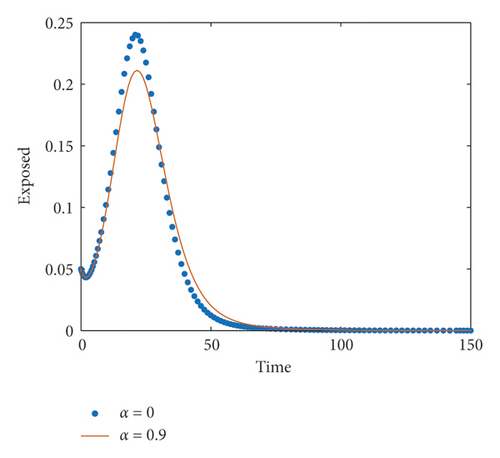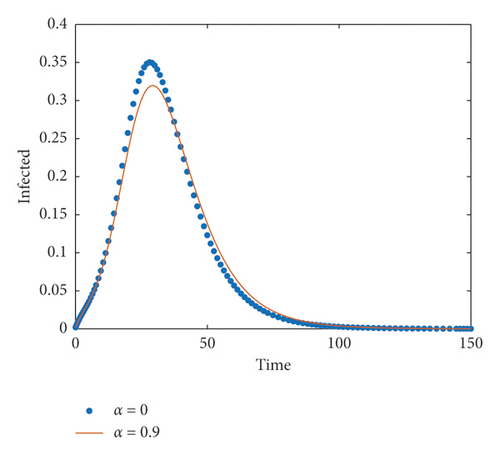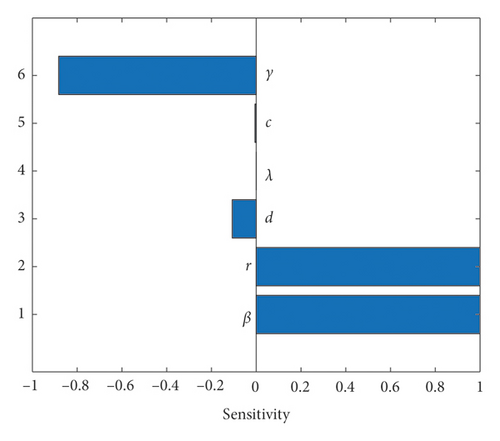Impact of Media-Induced Fear on the Control of COVID-19 Outbreak: A Mathematical Study
Abstract
The COVID-19 pandemic has put the world in threat for a long time. It was first identified in Wuhan, China, in December 2019 and has been declared a pandemic by the WHO. This disease is mainly caused by severe acute respiratory syndrome coronavirus 2 (SARS-CoV-2). So far, no vaccine or medicine has been developed for the proper treatment of this disease, so people are afraid of getting infected. The pandemic has placed many nations at the door of socioeconomic emergencies. Therefore, it is very important to predict the development trend of this epidemic, and we know mathematical modelling is a basic tool to research the dynamic behaviour of disease and predict the spreading trend of the disease. In this study, we have formulated a mathematical model for the COVID-19 outbreak by introducing a quarantine class with media-induced fear in the disease transmission rate to analyze the dynamic behaviour of this epidemic. We have calculated the basic reproduction number R0, and we observed that when R0 < 1, disease-free equilibrium is globally stable whereas if R0> 1, then the system is permanent and there exists a unique endemic equilibrium point. Global stability of the endemic equilibrium point is developed by using Li and Muldowney’s high-dimensional Bendixson criterion. Finally, some numerical simulations are performed using MATLAB to verify our analytical results.
1. Introduction
Over the past two decades, two known coronavirus outbreaks of SARS [1] and MERS [2] have been detected in humans. COVID-19 is an abbreviated form of severe acute respiratory syndrome coronavirus 2 (SARS-CoV-2) which has not been identified previously in humans. This disease is mainly transmitted through direct human-to-human contact, but there are pieces of evidence and work which claim that it can also be transmitted indirectly through fomites in the immediate environment around the infected person [3–5]. It is reported that COVID-19 affects different people in different ways. Most infected people develop mild to moderate symptoms such as fever, fatigue, and dry cough, although some patients suffer from headaches, abdominal pain, diarrhoea, and vomiting [6]. On average, symptoms may appear in 5 to 6 days from when someone is infected with the virus, but sometimes it can take up to 14 days [6]. In [7], Jiang et al. estimated that the fatality rate of this virus is nearly about 4.5%, but for the age group of 70–79 years, it has gone up to 8%. This disease is more critical for elder people who have other diseases such as diabetes, asthma, and cardiovascular disease [6]. It is reported that a COVID-19-infected person can make around 2.5 people infected [8]. People are concerned about their health, but the infection rate and death rate of the disease are increasing day by day and they are terrified to see this type of news through the media, so a wave of fear has been developed in the society.
Human behaviour plays an important role in spreading epidemics [9, 10]. They are also affected by a variety of factors, fear being one of them. Modelling studies have shown that fear has a significant effect on reducing the severity of a pandemic [11–13]. Fear has been shown to be directly related to social distance behaviour and caution [14, 15].
Due to fear, people are always scared to come into an open area and they are refraining from their daily activities in free environment. People may be terrified for a variety of reasons such as seeing a person who is suffering from COVID-19, but the fastest way is mass media [16]. The current outbreak has been much more prominent in media coverage than recent epidemics, including Ebola. For example, a Time Magazine study shows that there were 23 times more articles in English-language print news covering the coronavirus outbreak in its first month compared to the same time period for the Ebola epidemic in 2018 [17]. Media influence plays a significant role in spreading useful information’s through various sources such as television, community radio, Internet, and print media (such as newspapers and magazines), resulting in changed behaviour of a community [18]; therefore, it is influencing the progression of a pandemic [19, 20]. So, media-induced fear has a negative effect on the disease reproduction rate. Recently, Mohsen et al. [21] studied the global stability of a COVID-19 model with quarantine strategy and media coverage effects. According to Ahorsu et al. [22], one unique feature of pandemic viral infections is the fear that they can instill across large swathes of the population. Liu et al. [23] showed that mass media exposure had a significant positive impact on social networking service involvement and subjective norms, while preventive behaviour was largely affected by subjective norms; social networking service involvement had a significant positive effect on negative emotions, and excessive preventive intention was mainly influenced by negative emotions. Mathematical modelling is one of the best ways to express the dynamics of an epidemic. There are many infectious disease models, and most of them use differential equation systems for describing population dynamics with different characteristics in relation to infection [24–26]. Sardar et al. [27] study the effects of lockdown on future case counts in some estates and overall India. Sarkar et al. [28] proposed and analyzed a mathematical model to study the transmission dynamics of COVID-19 or SARS-CoV-2, where they performed the model validation with real data from India and some provinces of India. A mathematical model was used by Roy and Roy Bhattacharya [29] to predict the pandemic spread in India by using the data from 1 March 2020 to 23 April 2020 and they showed that the imposition of nationwide lockdown has played a significant role in restricting the spread of the pandemic. Hattaf and Yousfi [30] proposed a within-host model, which describes the interactions between SARS-CoV-2, host pulmonary epithelial cells, and cytotoxic T lymphocyte cells. Feng et al. [31] studied a COVID-19 model with the effects of media and quarantine in the UK. Chang et al. [32] proposed an SIHRS model which incorporated awareness of media coverage, which plays an important role in preventing and controlling infectious diseases. Some other works can be found in [33–36]. Inspired by above all these works, we have formulated a modified SEIR model to discuss the impact of fear on the disease transmission rate through media alertness. Generally, the disease transmission rate is related to the alertness of the disease in healthy people as well as related to the spreading ability of the disease. Thus, media coverage influences disease control in society.
The paper is organized as follows. In Section 2, we have formulated a mathematical model for the epidemic COVID-19, incorporating media coverage. Positivity and boundedness of the solutions of system (2) are performed in Section 3. The basic reproduction number is calculated and the stability of disease-free equilibrium is discussed in Section 4. The local and global stability of the endemic equilibrium point is presented in Section 5. Some numerical simulations are performed in Section 6 to validate our results. A brief discussion is given in Section 7.
2. Model Formulation
- (i)
f(0, I) = 1, i.e., in the absence of fear, there is no reduction in the disease transmission rate
- (ii)
f(α, 0) = 1, i.e., when there is no infected population, there is no reduction in the susceptible population due to fear
- (iii)
limα⟶∞f(α, I) = 0, i.e., when the amount of fear is very large, the disease transmission rate reduces to zero.
- (iv)
limI⟶∞f(α, I) = 0, i.e., when the infected population is very large, the disease transmission rate reduces to zero due to the large fear factor
- (v)
(∂f(α, I)/∂α) < 0, i.e., with the increase of fear, the disease transmission rate reduces
- (vi)
(∂f(α, I)/∂I) < 0, i.e., as the infected population increases, the disease transmission rate decreases
| Parameters | Interpretation |
|---|---|
| r | Recruitment rate of susceptible which includes immigrants and newborns |
| β | Disease transmission rate |
| µ | Natural death rate of population |
| c | Infection rate from exposed class |
| γ | Rate at which infected people are getting isolated |
| d | Disease-induced death rate |
| d1 | The rate at which infected people are recovered |
| λ | Recovery rate from isolated class |
| α | The effect of fear through media coverage |
3. Positivity and Boundedness of the Solution
For biological validity of system (2), it is necessary to prove that all solutions of system (2) with positive initial values will remain positive for all time t > 0. Thus, in this section, we want to prove the positivity and boundedness of solutions of our considered system.
Lemma 1. All solutions (S(t), E(t), I(t), Q(t), and R(t)) of system (2) with positive initial data will remain positive for all t > 0.
Proof. From the first equation of system (2), we get
Thus,
Similarly, it can be shown that E(t) > 0, I(t) > 0, Q(t) > 0, and R(t) > 0 for all t > 0.
Lemma 2. The closed set is positively invariant for system (2).
Proof. Adding all the equations of system (2), we obtained the rate of change of total population, which is given by
It follows that (dN/dt) ≤ 0 whenN ≥ (r/μ). By using a standard comparison theorem [38], we can show that
Thus, we have N(t) ≤ (r/μ) as t⟶∞. Hence, Π is positively invariant so that the region Π attracts all solutions in .
4. Reproduction Number and Stability Analysis of Disease-Free Equilibrium
Basic reproduction number is one of the most important threshold parameters which can determine whether the infectious disease will die out or spread through the population as time increases. Here, we calculate the basic reproduction number for the COVID-19 model through the next-generation matrix method [39].
Theorem 1. The disease-free equilibrium point E1 is locally asymptotically stable if R0 < 1 and unstable if R0 > 1.
Proof. Local stability of E1 can be established by evaluating the Jacobian matrix at disease-free equilibrium. The Jacobian matrix at E1 is given by
The eigenvalues of the characteristic equation of J(E1) are −µ, −µ, and −(λ + µ), and the other two eigenvalues are the roots of the equation:
Clearly, if R0 < 1, then all roots of equation (11) are negative, and if R0 > 1, then equation (11) has one positive real root. Hence, if R0 < 1, then disease-free equilibrium E1 is locally asymptotically stable; otherwise, it is unstable.
Theorem 2. The disease-free equilibrium E1 is globally asymptotically stable if R0 < 1.
Proof. From the first equation of system (2), we obtain (dS/dt) ≤ r − μS. Now S = (r/μ) is the globally asymptotically stable equilibrium of (dS/dt) ≤ r − μS, so for any given ∈>0, we have
Thus, we get
System (13) has a unique equilibrium (0, 0, 0) and the corresponding eigenvalues are −(λ + µ) and the roots of the equation:
For sufficiently small ∈>0, the quantity (c + μ)(γ + d + d1 + μ) − cβ((r/μ) + ɛ) > 0 if R0 < 1. Thus, all eigenvalues of equation (14) have negative real parts. Hence, (0, 0, 0) is locally stable. It is easy to prove that equilibrium point (0, 0, 0) is globally asymptotically stable for R0 < 1. Therefore, by comparison, it follows that limt⟶∞E(t) = 0, limt⟶∞I(t) = 0 and limt⟶∞Q(t) = 0.
Then, for above ɛ> 0, there exists a T > 0 such that if t > T, E(t) < ɛ, I(t) < ∈, and Q(t) < ɛ. From equation (2) of system (2), we get
For sufficiently small ɛ > 0, we observed that (r/βɛ + μ) is a globally asymptotically stable equilibrium of
Thus, by comparison, we have
As, this inequality holds for sufficiently small >0, and thus
Therefore, from equations (12) and (18), we get
Hence, disease-free equilibrium E1 is globally asymptotically stable if R0 < 1.
5. Existence of Endemic Equilibrium and Stability Analysis
Let us choose m1 = c + µ, m2 = d + d1 + γ + µ, and m3 = λ + µ.
Therefore, the endemic equilibrium point E2 will be feasible when R0 > 1.
Theorem 3. The endemic equilibrium point E2 is locally asymptotically stable if R0 > 1.
Proof. The characteristic equation of J(E2) is given by
Clearly, equation (21) has two negative real roots t1 = −µ and t2 = −(µ + λ) and the other three roots of equation (21) are obtained from the following equation:
Now if R0 > 1, then C > 0 and AB−C > 0. So, it follows from Routh–Hurwitz criteria [40] that all roots of equation (23) have negative real parts. Hence, the endemic equilibrium point E2 is locally asymptotically stable if R0 > 1.
Remark 1. From the above analysis, we observed that when R0 < 1, only the disease-free equilibrium E1 exists and it is locally as well as globally stable. Again when R0 > 1, the endemic equilibrium point E2 exists and is asymptotically stable, but in this case the disease-free equilibrium loses its stability and becomes unstable in nature. Therefore, we may conclude that there is a change of feasibility as well as stability at R0 = 1. Using the articles [41–43], it is concluded that the system undergoes a transcritical bifurcation at R0 = 1.
Theorem 4. System (2) is uniformly persistent in the region Π if and only if R0 > 1.
Proof. Consider that η is any point in the positive octant and o(η) is any orbit through the point η where Ω(η) is the bounded omega limit set of the orbit through η. Clearly, Ω(η) is bounded. Suppose the disease-free equilibrium point E1 is not in Ω(η). If E1 ∈ Ω(η), then by Butler–McGehee lemma [44], there exists a point x in Ω(η)∩Ws(E1), where Ws(E1) is the stable manifold of E1. Since o(x) lies in Ω(η) and Ws(E1) is in the S-Q-R plane, it can be concluded that o(x) is unbounded, which is a contradiction. Thus, Ω(η) does not intersect any of the coordinate planes; hence, system (2) is persistent. Again since system (2) is bounded so by the main theorem proposed by Butler et al. [45], the system is uniformly persistent.
Again since system (2) is uniformly persistent, there exists a time T such that (S(t), E(t), I(t), Q(t), R(t)) > for t > T.
To investigate the global stability of the endemic equilibrium point of system (2), we first reduce our system as recovered class does not have any effect on the dynamics of S, E, I, and Q class. So system (2) can be written as
Here, we apply the high-dimensional Bendixson criterion which is developed by Li and Muldowney [46] to prove the global stability of the endemic equilibrium point E2. Consider the open set G ⊂ Rn. Let us consider the following differential equation:
Consider B is a general 4 × 4 matrix denoted by B = (aij)4×4, and then, its second additive compound matrix B2 is defined by
To derive a high-dimensional Bendixson criterion as shown in [38], one has to show that the second compound equation
Next, we state the following lemma which is used in [47].
Lemma 3 (see [46].)Let G ⊂ Rn be a simply connected region. Assume that the family of linear systems (27) is equiuniformly asymptotically stable. Then
- (i)
G contains no simple closed invariant curves, including periodic orbits, homoclinic orbits, and heteroclinic cycles
- (ii)
Each semiorbit in G converges to a single equilibrium
In particular, if G is positively invariant and contains a unique equilibrium E¯, then E¯ is globally asymptotically stable in G.
Theorem 5. Assume that N(t) ≤ (r/μ) and R0 > 1. If there exist ω, θ, ξ, ρ, and ζ. such that max {b11 + (b12ω/θ) + (b14ω/ξ), (b21θ/ω) + b22, (b32/θ) + b33 + (b36/ς), (b42ξ/θ) + b44, b53ρ + (b54ρ/ξ) + b55 + (b56/ζ), (b65ζ/ρ) + b66} < 0, then the endemic equilibrium point E2 is globally asymptotically stable.
Proof. For model (24), we denote X = (S, E, I, Q)T and F(x) = (f1, f2, f3, f4)T. Then, the second compound matrix of system (24) can be written as
The second compound system (dZ/dt) = (∂F[2]/∂X)Z(t) then becomes
Now, define V(Z) = max{ω|z1|, θ|z2|, |z3|, ξ|z4|, ρ|z5|, ζ|z6|}.
From the direct calculation, we get the following inequalities:
Therefore, (d+/dt)V(Z(t)) ≤ ψVZ(t), with ϕ = max{b11 + (b12ω/θ) + (b14ω/ξ), (b21θ/ω) + b22, (b32/θ) + b33 + (b36/ς), (b42ξ/θ) + b44, b53ρ + (b54ρ/ξ) + b55 + (b56/ζ), (b65ζ/ρ) + b66} < 0.
Thus, from the assumption of the theorem, we find a positive constant η such that φ ≤ −η < 0, and hence, V(Z(t)) ≤ V(Z(s))exp(−η(t − s)), t ≥ s > 0.
This confirmed the equiuniform asymptotic stability of the second compound system. Therefore, system (2) or (24) has no nontrivial periodic solutions; hence, the endemic equilibrium point E2 of system (2) is globally asymptotically stable.
6. Case Study: World
Here, we performed some numerical simulations with some real data taken from [48,49] and some hypothetical data to observe the dynamics of our proposed COVID-19 model. For this simulation purpose, we used the following set of parameters, values of which are given in Table 2. The parameters are calculated per 1000/day and we assumed that the total population of the world is 7.6 billion. In terms of scaled variables, we assumed the initial population size is (S(0), E(0), I(0), Q(0), R(0)) = (1, 0.05, 0.002, 0.002, 0.003).
For this set of parameters, we calculate R0 = 3.1794 > 1. Hence, Theorems 3 and 4 are satisfied which means the system is persistent and it ensures the existence of the endemic equilibrium point E2. From Figure 1(a), we observed that, in the absence of media coverage, susceptible population is decreasing, but the exposed population and infected population are increasing over time which means more people are being exposed, and within a short time period, a large number of people are infected. From Figure 1(b), we also have seen that the recovered population is not growing as much as the infected population and exposed population. So, as a result, there is an outbreak within a short time span.


Now we introducing fear effect (α) into the model system (2), and here, our main focus is whether media-induced fear can affect the disease transmission rate or not. From Figure 2, we observed that when the value of α is increasing, the population rate of exposed as well as infected class is decreasing from their original position where remaining all other parameters are as above. So we conclude that fear has an important role in the dynamics of our proposed model.


From this analysis, we observed that JβR0 = 1, which implies if the disease transmission rate increases by 1%, then it will increase the value of R0 by 1% and vice versa. Again, we see that that means when increasing the value of γ by 1%, the value of R0 will be reduced by 0.88%. Thus, it can be concluded that reproduction number is positively correlated with the disease transmission rate but negatively correlated with γ. Therefore, to prevent disease transmission, it is necessary to obey social distancing or lockdown and isolate more infected people. A sensitivity analysis figure is plotted in Figure 3.

The effectiveness of 30-day lockdown or more is described in Figure 4. From this figure, we observed that 30-day lockdown is not sufficient to control the disease, but if we applied a lockdown for 75 days or more, then it shows that the lowest number of people infected and the epidemic may be under control.

7. Discussion
Media coverage plays an important role in the transmission process of infectious disease. People will be more aware of COVID-19 infection if they learn more about the transmission of the disease through media; as a result, they will change their behaviour and take correct precautions such as frequent handwashing, wearing masks, maintaining social distance, reducing party to take risk aversion, and even isolating themselves at home to avoid contacting with others. Modelling studies have shown that fear has a significant effect on reducing the severity of a pandemic and it has been shown that fear is directly correlated with the increase in social distancing behaviour as well as taking more precautions. Thus, in this paper, we have formulated a mathematical model with media-induced fear to analyze the epidemic of COVID-19. Analytically, we proved that system stability mainly depends on the basic reproduction number R0. We have seen that if R0 > 1, then the endemic equilibrium point exists and is globally asymptotically stable which means the disease persists in the system. So, to avoid such circumstances, we must focus on the disease transmission rate. From sensitivity analysis, we also observed that reproduction number is positively correlated with the disease transmission rate. If the disease transmission rate is very low, then people are less exposed and we can control the epidemic. Numerically, from Figure 2, we conclude that if the rate of fear increases through media, then it can reduce the infection rate, and increasing the amount of fear can stabilize the system.
Conflicts of Interest
The author declares that there are no conflicts of interest.
Open Research
Data Availability
All supportable data are given in the main text.




